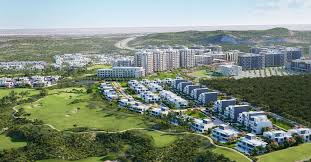
Foreign Investment in Pakistan
Real Estate – Current Trends
For
decades, real estate in Pakistan has been regarded as one of the most reliable
ways to secure wealth and build long-term financial stability. The sector
traditionally thrived on the interest of local investors and end-users, but
over the past few years, the dynamics have begun to shift. A growing number of
overseas Pakistanis, as well as foreign stakeholders, are now becoming active
players in the property market. This rising international interest is being
driven by several factors: proactive government policies designed to attract
capital, the introduction of digital banking and financing tools that simplify
cross-border transactions and the rapid pace of infrastructure development
across the country. As we step into 2025, these elements are working together
to reshape the flow of foreign investment, making Pakistan’s real estate sector
more accessible, transparent, and promising than ever before.
Overseas
Pakistanis Driving Real Estate Growth through RDA and Roshan Apna Ghar
Overseas
Pakistanis continue to play a vital role in driving foreign investment into the
country’s real estate market. Their contributions are not only consistent but
also steadily increasing as new opportunities and streamlined processes emerge.
The government’s initiatives, particularly the Roshan Digital Account (RDA) and Roshan Apna Ghar scheme, have transformed the way expatriates
participate in property investments. These platforms allow overseas Pakistanis
to buy and finance properties remotely with greater ease, providing them with
secure payment channels, access to housing finance, and the assurance that
their profits can be repatriated without unnecessary hurdles. The impact of
these reforms is evident from recent data, which revealed that in January 2025 alone, expatriates invested more
than PKR 16 billion in Islamabad’s real estate sector. This surge
reflects a strong vote of confidence in the local property market. Key
destinations attracting this capital include well-established developments such
as DHA, Bahria Town, and Gulberg Islamabad, alongside emerging hubs like
Blue World City and strategic CPEC-related zones in Gwadar, where
long-term growth prospects are particularly strong.
Foreign Direct
Investment (FDI) in Real Estate
While
remittances and overseas Pakistani investments remain a strong source of
capital for property, formal foreign direct investment (FDI) in Pakistan’s real
estate and construction sectors has struggled to gain momentum. Official data
confirms that the construction sector’s
FDI declined sharply from US $155 million in FY2021 to US $79 million in FY2022,
reflecting the cautious stance of global investors. The reasons behind this
limited inflow include regulatory hurdles, policy uncertainty, and concerns
over investor protection. Recognizing these challenges, the government introduced
the Investment Policy 2023,
which aims to create a more investor-friendly environment.
Key
reforms include the abolition of the
minimum equity requirement for foreign investors and the removal of restrictions on foreign developers
in the housing and commercial real estate sectors. The policy also sets
an ambitious target of attracting US
$20–25 billion in FDI across multiple industries, with real estate
positioned as a priority area for growth.
Emergence of Real
Estate Investment Trusts (REITs)
One of the
most significant shifts taking place in Pakistan’s property sector is the emergence of Real Estate Investment Trusts
(REITs). These
investment vehicles are changing the way both local and foreign investors
participate in the market by offering a structured, regulated, and more
accessible alternative to direct property ownership. Instead of purchasing and
managing individual plots or buildings, investors can now buy shares in a professionally managed property
portfolio. This
model is particularly attractive for overseas
Pakistanis and international institutions, as it allows them to
benefit from Pakistan’s real estate growth while avoiding the complications of
managing assets from afar.
REITs also provide several advantages that traditional real estate investments often lack. They distribute regular dividends, operate under transparent regulatory frameworks, and typically carry lower risk, since investments are spread across multiple assets rather than concentrated in a single property. Recognizing their potential to draw institutional capital and enhance liquidity in the market, the government has taken deliberate steps to promote their adoption. In the 2025 federal budget, special incentives were introduced, including tax exemptions on REIT dividends and a reduction in corporate tax rates for REIT entities. These reforms signal a strong policy shift toward institutionalizing real estate investment and creating a more investor-friendly environment. If these initiatives gain traction, REITs could play a pivotal role in transforming Pakistan’s real estate sector into a more modern, transparent, and globally competitive market.
Strategic
Infrastructure & CPEC’s Impact
Any
conversation about foreign investment in Pakistan’s real estate sector would be
incomplete without highlighting the role of the China Pakistan Economic Corridor (CPEC). Since its
launch, CPEC has had a transformative effect on the country’s property market,
creating entirely new investment opportunities while reshaping existing ones.
The establishment of Special
Economic Zones (SEZs) under CPEC has triggered sharp increases
in land values by some estimates, as much as 50% in certain regions. Nowhere has this impact been more
visible than in Gwadar, where
property prices have surged by nearly 300%
over the past decade, fueled by expectations of trade growth, port development,
and industrial expansion.
Beyond Gwadar,
the broader network of motorways,
ports, and industrial
corridors built under CPEC has improved connectivity between
major urban centers. Cities such as Islamabad, Rawalpindi,
and Lahore have experienced rising property demand as a result,
particularly in housing societies located along these new routes. Developments
like Capital Smart City, Rudn Enclave, and Blue World
City are prime examples of projects that have directly
benefited from enhanced accessibility, making them attractive not only to local
buyers but also to overseas Pakistanis seeking long-term gains. The influence
of CPEC is not limited to metropolitan areas. Improved infrastructure has also
opened up opportunities in tourism-driven
regions such as Skardu and Hunza, where better roads and facilities
are encouraging the growth of hospitality, resort, and residential projects.
This combination of industrial, urban, and tourism-focused development
illustrates how CPEC has become a catalyst for real estate expansion across
Pakistan, positioning the sector as a key beneficiary of the country’s largest
infrastructure initiative.
Recent Deals
& Foreign Partnerships
Foreign
investment in Pakistan’s property sector is no longer limited to traditional
residential projects; it is increasingly entering the market through mergers, acquisitions, and joint ventures. According to the Competition Commission of Pakistan (CCP),
during FY2024–25, a total of 69 merger and acquisition deals
were approved, representing nearly US
$50 million in foreign direct
investment (FDI) across a range of industries. While
these transactions spanned multiple sectors, a significant portion was tied to
real estate-related activities such as logistics,
infrastructure, and
industrial development, which directly support property growth.
Several
high-profile agreements stand out. For instance, DP World Logistics
from the UAE partnered
with Pakistan’s National Logistics Cell (NLC)
under the umbrella of the Special
Investment Facilitation
Council (SIFC), a
move expected to strengthen both logistics infrastructure and the commercial
property market. Similarly, Italy’s
Euricom S.P.A. entered into a joint venture in Pakistan’s rice
milling sector, indirectly boosting demand for industrial real estate linked to agro-processing.
Meanwhile, Berkeley Square Holding BV
acquired stakes in prominent advertising and media firms, reflecting growing
foreign interest in Pakistan’s urban
business and commercial property ecosystem.
On
a broader scale, foreign partnerships expanded further in September 2025, when Pakistan and China signed
agreements worth US $8.5 billion. These included nearly $1.5 billion in joint ventures spanning industries such as steel, renewable energy, agriculture,
and industrial production.
While these investments are not purely real estate transactions, they are
expected to drive demand for commercial
offices, warehouses, and industrial zones, demonstrating how foreign capital in
diverse sectors continues to fuel growth across Pakistan’s property landscape.
Regulatory &
Fiscal Reforms
To build
confidence among investors and bring greater stability and transparency to the property market, the
government has rolled out a series of regulatory and fiscal measures. One of
the most notable steps has been the introduction of a flat 15% capital gains tax for active taxpayers. This
move not only simplifies the taxation process but also helps curb speculative short-term
buying and selling, which has long fueled artificial price hikes in the market.
In addition,
property valuation rates have been revised
upward by nearly
75% across 56 major cities.
By aligning official valuation benchmarks more closely with actual market
prices, the government aims to reduce underreporting of property values,
increase documentation, and improve revenue collection. This adjustment also
helps establish a more transparent investment environment, making it easier for
both local and foreign investors to assess the true worth of real estate
assets.
Looking
ahead, further investor-friendly reforms are
under consideration. Proposals include the creation of a specialized real estate regulatory authority
under the Special Investment
Facilitation Council (SIFC), as well as streamlining approval processes for foreign developers
and in situational investors. Together, these measures are designed to minimize bureaucratic hurdles, strengthen
investor protection, and build trust. If fully implemented,
they could play a decisive role in making Pakistan’s property sector more
attractive to long-term foreign capital.
Real Estate as a
Safe-Haven Asset
Despite
ongoing economic headwinds, Pakistan’s real
estate sector continues to stand out as one of the most reliable avenues for wealth
preservation. For both local and foreign investors, property
remains a preferred hedge against inflation
and currency depreciation,
offering stability that few other asset classes can match. One of its strongest
appeals is the steady stream of income it generates major cities such as Islamabad, Lahore, and Karachi
consistently deliver rental
yields averaging between 6–7% annually, making property an attractive option for those seeking regular
returns.
Beyond rental income, the
potential for long-term capital appreciation adds another layer of security.
Investors who hold assets over time often benefit from rising land values,
especially in high-demand urban areas and regions linked to infrastructure
growth. Compared to the volatility of equity markets or the unpredictability of
currency fluctuations, real estate offers a tangible, resilient, and relatively low-risk investment.
For foreign buyers in particular,
Pakistan’s property market presents an appealing entry point. Prices remain
comparatively lower than many regional markets, allowing investors to acquire
assets with strong growth potential at accessible costs. This blend of
affordability, income stability, and long-term appreciation ensures that real
estate retains its reputation as a safe-haven
asset, particularly
for those looking to balance security with sustainable returns in an emerging
market.
Final Thoughts
Foreign
investment in Pakistan’s real estate sector is gradually moving beyond sporadic inflows and shifting
toward a more structured, policy-driven
framework. This
evolution reflects the government’s ongoing efforts to modernize the market,
attract long-term capital, and create opportunities that appeal to both
individual expatriates and institutional investors. Still, the sector faces
important challenges—chief among them the need for clear regulations, consistent political stability, and stronger investor
safeguards to ensure
that foreign capital feels secure.
At present,
the Pakistani diaspora remains the backbone of foreign
investment, fueling
steady growth through remittances and property acquisitions. However, with the
introduction of reforms, the expansion of Real
Estate Investment Trusts (REITs), and the transformative impact of CPEC-linked infrastructure and economic
zones, the landscape
is broadening to include institutional
players and
direct foreign investors. This gradual diversification signals
a more mature and globally integrated real estate market in the making.
If
Pakistan is able to maintain
reform momentum, strengthen transparency, and build long-term trust among
investors, its
property sector could position itself as one of the most attractive
destinations in South Asia. With a combination of affordability, strategic
location, and growing international interest, Pakistan’s real estate market is
on the cusp of becoming not just a safe-haven for wealth, but also a dynamic
engine of investment-driven growth.


